Photo credits: rawpixel, illustrations: Nicolas Naveau, Ars Electronica Futurelab
What will our street traffic look like when automated vehicles become a reality? How will a traffic cop work in a world where cars drive themselves? And what will a driving instructor do when no one needs a driver’s license anymore?
Maria Pfeifer, a researcher at the Ars Electronica Futurelab, has examined this question intensively over the past few months. She is responsible for a study on behalf of the Austrian Road Safety Board (Kuratorium für Verkehrssicherheit or KFV) on the topic of careers of the future in the fields of mobility and logistics in the transport sector. Based on current developments, the study describes various future scenarios for the year 2050 and provides detailed descriptions of jobs that could perhaps develop in a world with level 5 automation.
In this interview, Maria Pfeifer and Klaus Robatsch, head of the road safety division at KFV, explain how we could move through traffic in 2050 – and exactly what goes into such a comprehensive study.
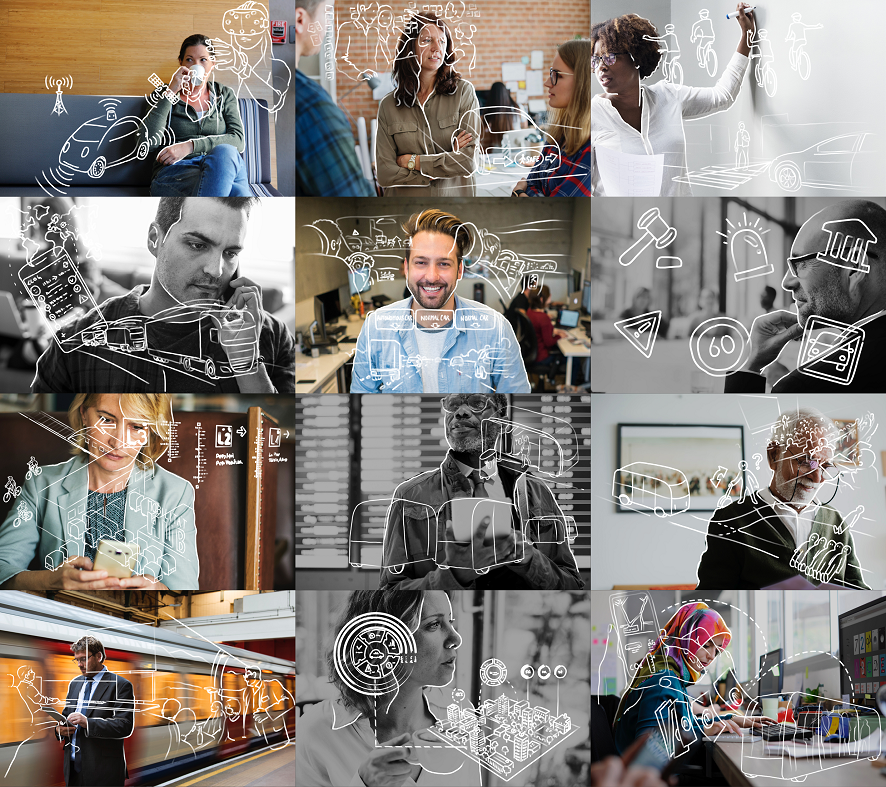
Photo credits: rawpixel, illustrations: Nicolas Naveau, Ars Electronica Futurelab
Maria, over the last few months you have focused intensively on the future of careers in mobility and logistics. The goal was a study for the Austrian Road Safety Board – how do you approach such a wide-ranging task?
Maria Pfeifer: The area we wanted to examine was very well-defined: it was supposed to be about jobs related to logistics or road safety in light of automation, taking into account aspects such as the sharing economy and digitalization. How will these job categories and jobs change in the future and what new kinds of jobs will be created? Above all, we considered how a study can be drawn up in such a way that it covers all these levels – the future of work, the future of mobility, and the effects on society – but remains comprehensive at the same time. In the end we decided to develop different scenarios, always based on the visions of the future that already exist. With that in mind, we had many consultations with experts and adapted our scenarios accordingly.

Illustrations: Nicolas Naveau, Ars Electronica Futurelab
The study on careers of the future is part of a larger series – how do the considerations about transport jobs of the future fit into that?
Klaus Robatsch: The KFV has been engaged for some time with the potential effects of modern driver assistance systems and automated driving on driver education and testing. In the currently ongoing project A.M.A – Automatisierung.Mensch.Ausbildung (Automation.People.Education), those subjects are currently being dealt with. However, while working on the project it quickly became clear that modern driver assistance systems and automated vehicles can and probably will affect many more areas related to mobility and road safety, not just driver education. Carrying out the study on careers of the future is the logical consequence of these considerations.
The study goes beyond the scenarios and even develops highly specific descriptions of future careers…
Maria Pfeifer: That was our second special gimmick. Scenarios are very typical in this line of research: assumptions are made and then predictions are determined based on those. We added personas to the scenarios – something that is more common in product development or target demographic research. You think up specific people with wishes, goals, hopes, a name and a CV, so you really keep the user in mind. Finally, we mixed this with archetypes, in other words the opposite of a persona. An archetype is a cliché of a certain type of person. With these two methods, examples of future jobs came about that are based on the real facts of this moment in time. We really took a look at what logistics or mobility jobs exist right now and considered how they could change. That’s why the jobs we identified often don’t actually sound all that futuristic!
Each job description comes with an “I statement” about their everyday work and a photo of the person. We provided more precise descriptions of some special jobs, a guide to their competence and a sort of activity log, so you can understand in detail how this person’s everyday work would look.

Photo credits: rawpixel, illustrations: Nicolas Naveau, Ars Electronica Futurelab
We are of course very excited to hear about some of these jobs. But first can you describe the scenarios they are based on?
Maria Pfeifer: In order to even be able to play this game of ideas for scenarios, we established two premises. First, in our hypothetical future, so-called level 5 automation will be possible, in other words vehicles that are fully self-driving without human involvement. Secondly, we assume that CO2 emissions and other environmental issues are under control to the extent that traffic on a large scale remains possible.
Our first scenario is called “Humans in Control” and describes a conservative world that is not that different from our present. People are skeptical of technology, only some roads allow automated vehicles, and everyone still has a private car. The second scenario is called “Private Autonomy.” Cars and trucks are automated, there are no more driver’s licenses. Although automated driving is already very safe and comfortable, everyone still has their own car and there is a lot of traffic on the streets. There is a high acceptance of technology and not much car sharing.
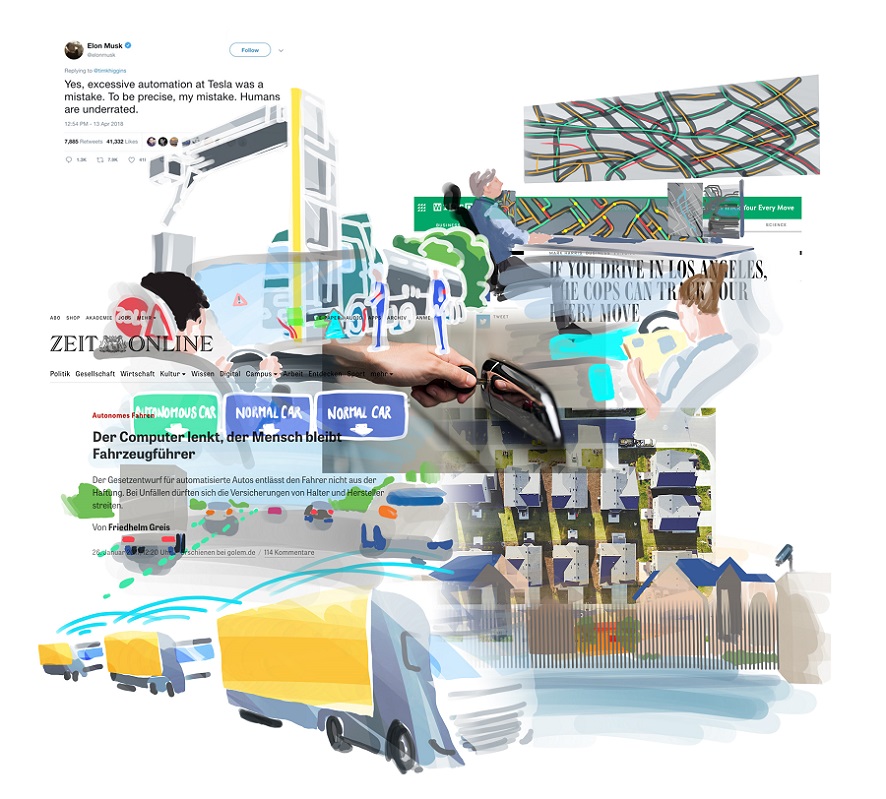
Illustrations: Nicolas Naveau, Ars Electronica Futurelab
Our third scenario, “On Demand City,” also has only automated traffic, but here the vehicles are not privately owned. It is a pure car sharing model. Here we took the principle of “use rather than own” to the extreme – people only pay for the trips they are taking, not for a private car. And finally, our last scenario is called “A Brave New Green” and is based on sustainability. Here there’s only automated traffic, but it’s not on demand – it’s public transport, which is strictly regulated according to driving plans. Rural areas are also well served, there may be mobility cooperatives in small communities that buy a small fleet. Traffic is regulated according to a cap system with everyone having a mobility account. People who often walk or bike may be able to afford a long-distance trip after a few years…
The scenarios are not conceived as either/or. We developed them in order to have fertile ground for our ideas about jobs to grow. They help us to demonstrate the multiplicity of possibilities and show how jobs could change with changing conditions. A traffic cop’s job in the “Humans in Control” scenario surely looks very different from that of a traffic cop in “A Brave New Green.”
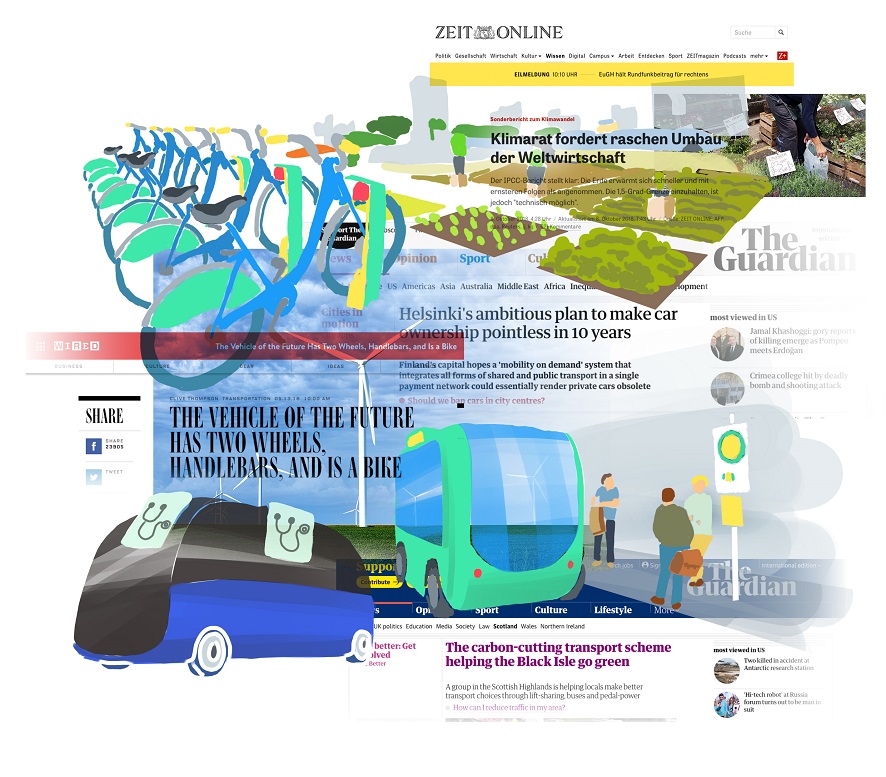
Illustrations: Nicolas Naveau, Ars Electronica Futurelab
There are over 60 jobs contained in these 4 scenarios. Can you give me a few examples?
Maria Pfeifer: There are of course many jobs that heavily involve IT, networks or similar technologies. But I’m especially excited by the jobs that that don’t seem that digital when you first look at them. For example, what kind of work would a street sign designer do when street signs are no longer made for people, but rather for machines?
It is also interesting which jobs might stay very human: you might want to get your mail from a person in spite of all the other possibilities, for the social exchange or other helpful services? Maybe there will also be driving companions who make it more entertaining to drive in an automated vehicle or can accompany minors. When elevators were first developed, there was always a lift boy to push the button… That was a typical job for our scenario “Humans in Control.” In a world like that, will there also always be a contact person from the relevant transport operator on board? What happens if that’s not the case – and you have a technical problem in a remote area?
There could also be an exciting development with driving instructors. When driver’s licenses are no longer necessary, there may be obligatory mobility training that shows how to conduct yourself in this new kind of traffic.

Photo credits: rawpixel, illustrations: Nicolas Naveau, Ars Electronica Futurelab
From these job descriptions, there were a couple of trends that emerged…
Maria Pfeifer: Exactly. With the trends, we are very concerned about how we have to prepare for the future, what kind of training it requires, and how we can develop our abilities accordingly.
One trend is the increasing importance of a basic digital understanding. On the other hand, we also see that social competence is becoming essential – the more routine jobs are done by machines, the more important it becomes to respond to the individual needs of our fellow people. But how do you teach social competence in a job-training program? That is definitely harder than teaching specialized knowledge.
And to dig deeper into the topic of knowledge: here we see that it is becoming increasingly important to be constantly learning new things. People who have just completed their studies may already be behind the curve in 5 years. So we built lots of micro-degrees and further education programs into the CVs we developed. A strong component of this is connecting different areas of competence. We talk about hybrid skills here. Of course we need specialists, but it’s becoming more and more important to understand systems and be able to link them up. These competencies could be very close to each other, such as sensory and network technology, but it could also be moral philosophy and programming.

Photo credits: rawpixel, illustrations: Nicolas Naveau, Ars Electronica Futurelab
What do these insights mean for the KFV?
Klaus Robatsch: The KFV road safety research division sees its competence in the topic of human-machine interaction and human factors. The Careers of the Future study will make a decisive contribution to our ability to take account of future developments in our daily work. Only if you have an idea of how mobility and the role of people in this area are changing, is it possible to carry out targeted road safety work. This is true to a large extent for current and future working environments for people, too. Safety must be guaranteed at work as well as on the way there. It’s similar with the topic of driver education. It takes time to create new legal terms and conditions and we can provide our expertise here as a road safety organization.
The results of these months of work is a research paper that also demands a lot of creativity. The scenarios are almost reminiscent of Science Fiction – how much fiction can this kind of research handle?
Maria Pfeifer: I think it always depends on what the goal is. When you’re researching the future, you need a certain amount of fiction. In the end, you can only explore images of the future in the present. Then you can speculate based on that. That is a very good way to begin speaking and reflecting on topics in the first place. It also has great communication potential when you put your insights and facts into fictional vessels – it’s just important to identify that clearly.
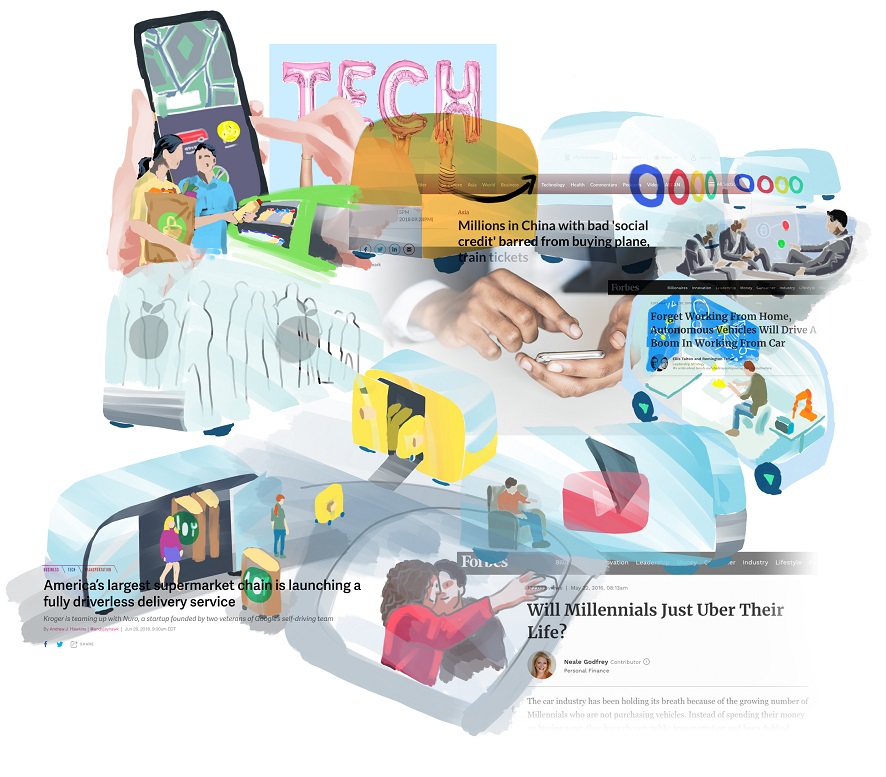
Illustrations: Nicolas Naveau, Ars Electronica Futurelab
The time horizon for the study is 2050 – which scenario for this not-so-distant future sounds best to you?
Klaus Robatsch: Each of the scenarios described has opportunities but also highly individual challenges for transport safety. If I could choose a future it would be Vision Zero, a future where no one is killed by street traffic, in which everyone taking part in transport is on equal footing and has the same level of safety. Road safety has to be a precondition for future developments in the field of automated driving, but limits on personal freedom should always be the last means of achieving that.
Maria Pfeifer: I would prefer to live in “A Brave New Green.” However, that’s easier said than done! Comfort is a very lucrative value creation strategy. It’s hard for us people to give that up of our own accord. Currently it’s made very easy for us to be comfortable, including in the mobility sector. Why shouldn’t a car pick me up right in front of my house? If something is practical it is also used. I think we need incentives and social strategies for helping people recognize what the effects actually are when you fly to another city for the weekend.
In “A Brave New Green,” however, there is also a dark side, and that is the intensive surveillance. So I actually hope it doesn’t have to go that far.
The study is available for download here.
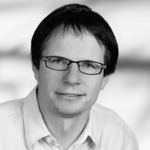
Dipl.-Ing. Klaus Robatsch is Head of Traffic Safety at the Austrian Road Safety Board. He graduated from the Höhere Technische Bundeslehranstalt für Tiefbau in Villach (1986) and studied spatial planning at the TU. Since 2014 he is National Focal Person for Injury Prevention of the WHO EURO Region and since 2000 he is a lecturer at the TU Vienna.

Maria Pfeifer is a Key Researcher at Ars Electronica Futurelab. Her main areas of interest are creative future research, innovation inspired by art, and collaboration between art and science. She is also responsible for the Artists in Residence. She studied art, comparative studies, and cultural studies in Vienna and wrote her Masters thesis in 2013 on the visualization of literature. Having worked for Ars Electronica Festival and Futurelab a number of times over the years, she finally became a full member of the Futurelab team in 2016.
To learn more about Ars Electronica, follow us on Facebook, Twitter, Instagram et al., subscribe to our newsletter, and check us out online at https://ars.electronica.art/news/en/.
